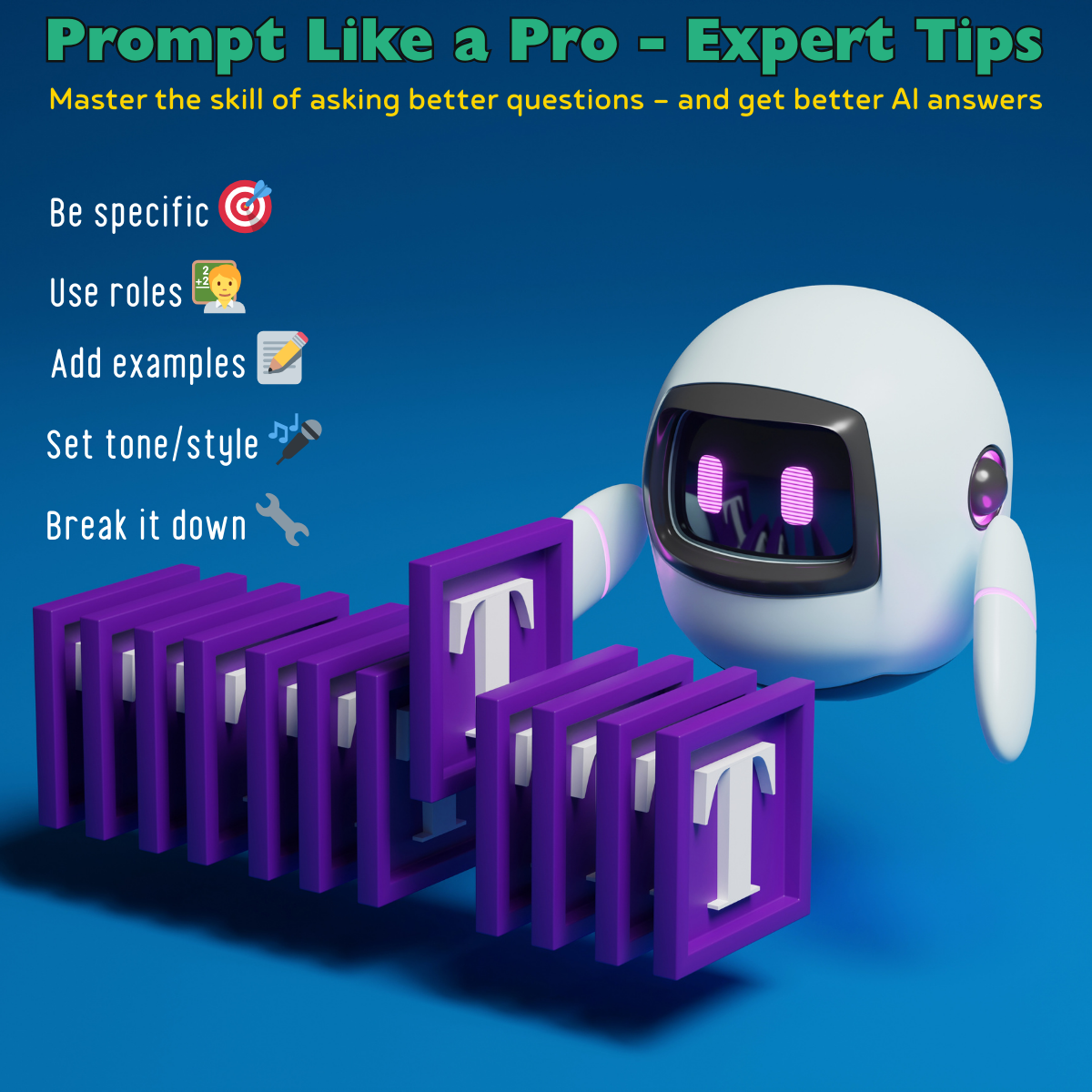Posted At: Aug 12, 2025 - 305 Views

✨ Prompt Like a Pro: Expert Tips for Getting Better Results from AI
AI tools are powerful, but how you ask matters. Whether you're writing content, coding, researching, or brainstorming, the quality of your prompt directly affects the quality of the AI's response. That’s where prompt engineering comes in.
In this blog, we'll explore practical prompting tips to help you get the most accurate, creative, and useful responses from AI consistently.
🧠 What Is a Prompt?
A prompt is the instruction or question you give to an AI tool. Think of it as your message to a very intelligent assistant. The clearer and more structured it is, the better the AI can help you.
🎯 Why Good Prompting Matters
- ✅ Reduces back-and-forth revisions
- ✅ Yields more accurate and relevant answers
- ✅ Helps AI understand your tone, audience, and intent
- ✅ Unlocks creative and unexpected ideas
- ✅ Saves time and enhances productivity
🔑 Top Prompting Tips for Better Results
1. Be Clear and Specific
Bad: “Tell me about marketing”
Good: “Explain 3 modern digital marketing strategies for B2B SaaS companies in under 150 words”
✅ Tip: Include context, desired format, and audience.
2. Use Role-Playing for Better Context
Start your prompt with:
“Act as a startup pitch coach…”
“You are a professional copywriter…”
“Imagine you’re a product manager at a tech company…”
🧠 This helps the AI adopt the right tone and mindset.
3. Break Big Tasks into Steps
Instead of asking for a full business plan in one go, say:
“Help me outline the key sections of a business plan for a mobile app startup.”
Then prompt:
“Great. Now write the executive summary based on this idea…”
🪜 This approach gets more structured, high-quality output.
4. Give Examples of What You Want
If you want a blog intro, show an example:
“Write a blog introduction like this: ‘In today’s fast-paced tech world…’ Now do one for the topic: AI in education.”
💡 Few-shot prompting = better alignment.
5. Use Templates or Patterns
Use prompts like:
“List of 10 ideas with pros and cons.”
“Compare option A vs option B in table format.”
“Summarize this text in 3 bullet points.”
📋 Structure guides the AI’s output format.
6. Ask for Iteration or Refinement
Don't stop at the first reply. You can say:
“Make it more concise.”
“Add a bit of humor.”
“Rewrite in a more formal tone.”
“Can you turn this into a LinkedIn post?”
🛠️ Treat AI as a collaborator, not a one-shot tool.
7. Use Constraints
Impose limits for clarity:
“Explain blockchain to a 5th grader in 3 short paragraphs.”
“Create a slogan under 10 words.”
“Generate a tweet with 280 characters max.”
✂️ Constraints increase precision and focus.
8. Chain Your Prompts (Chain-of-Thought)
Ask it to explain its reasoning:
“What are the pros and cons of this decision? List them first, then give me a recommendation.”
🧱 Encourages structured, logical answers.
9. Use System Prompts (For Developers)
If you're integrating AI via an API (e.g., OpenAI, Anthropic):
- Use system messages like:
“You are a helpful assistant for legal document summaries.”
🔧 Helps define behavior for long sessions or multi-turn conversations.
10. Prompt for Tone and Style
Guide the voice:
“Write in a friendly, casual tone.”
“Use a formal, academic writing style.”
“Make it sound like an Apple product ad.”
🎤 Voice matters, and you control it.
💬 Bonus: Prompting Do's & Don'ts
✅ Do | ❌ Don't |
Use context and structure | Be vague or overly broad |
Guide the tone and format | Expect perfect results blindly |
Iterate and refine | Assume first draft is final |
Use follow-up prompts | Forget to add constraints |
🧪 Try These Prompt Formulas
- “Explain [concept] in simple terms using analogies.”
- “Act as [expert] and help me [goal].”
- “Give me 5 options for [idea] and rank them by [criteria].”
- “Summarize this [text/link] into [format].”
🔮 The Future of Prompting
As AI tools evolve, prompting will become a key digital skill — like coding or SEO once were. Mastering it will help marketers, writers, developers, researchers, educators, and business owners stay ahead.
Soon, “prompt engineering” might not just be a job title — it’ll be a required skill across industries.
Prompting is part art, part science. With practice, you’ll learn how to shape conversations that unlock AI’s full potential.
🧠 Great prompts = great outputs.
Start experimenting today — and don’t forget, your next billion-dollar idea might begin with just one well-written prompt.
